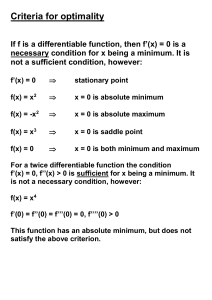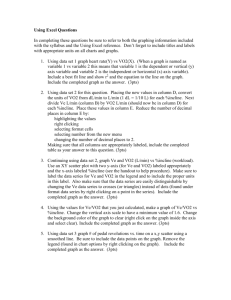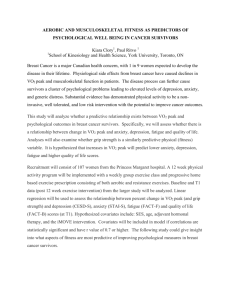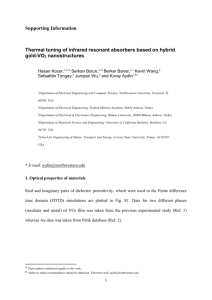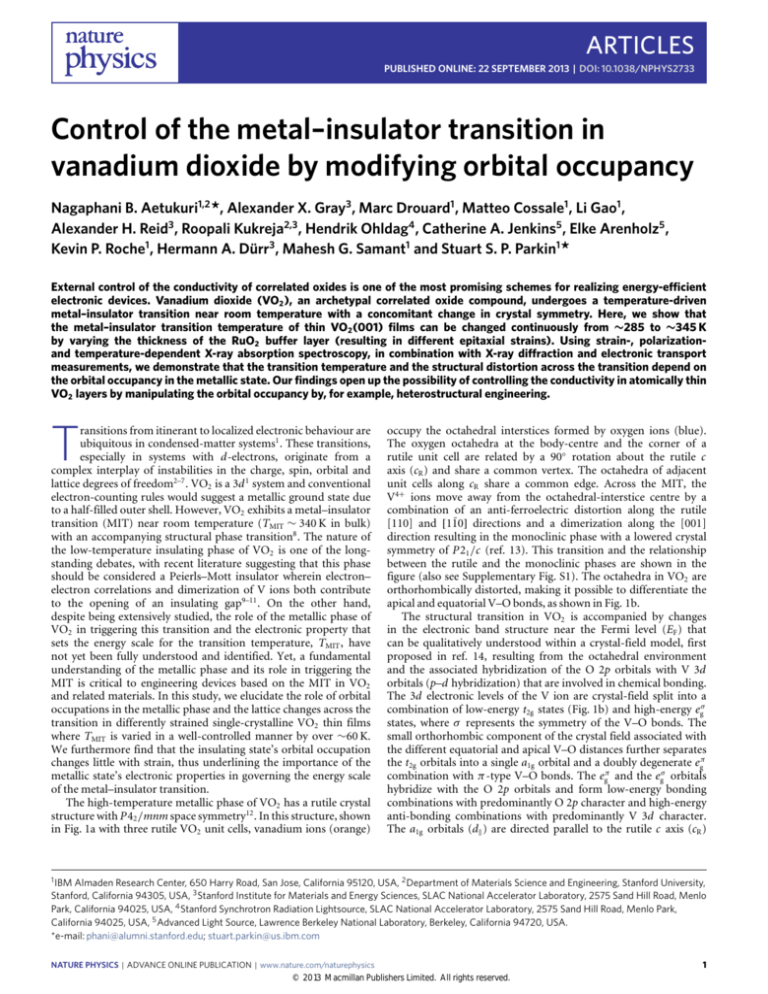
ARTICLES
PUBLISHED ONLINE: 22 SEPTEMBER 2013 | DOI: 10.1038/NPHYS2733
Control of the metal–insulator transition in
vanadium dioxide by modifying orbital occupancy
Nagaphani B. Aetukuri1,2 *, Alexander X. Gray3 , Marc Drouard1 , Matteo Cossale1 , Li Gao1 ,
Alexander H. Reid3 , Roopali Kukreja2,3 , Hendrik Ohldag4 , Catherine A. Jenkins5 , Elke Arenholz5 ,
Kevin P. Roche1 , Hermann A. Dürr3 , Mahesh G. Samant1 and Stuart S. P. Parkin1 *
External control of the conductivity of correlated oxides is one of the most promising schemes for realizing energy-efficient
electronic devices. Vanadium dioxide (VO2 ), an archetypal correlated oxide compound, undergoes a temperature-driven
metal–insulator transition near room temperature with a concomitant change in crystal symmetry. Here, we show that
the metal–insulator transition temperature of thin VO2 (001) films can be changed continuously from ∼285 to ∼345 K
by varying the thickness of the RuO2 buffer layer (resulting in different epitaxial strains). Using strain-, polarizationand temperature-dependent X-ray absorption spectroscopy, in combination with X-ray diffraction and electronic transport
measurements, we demonstrate that the transition temperature and the structural distortion across the transition depend on
the orbital occupancy in the metallic state. Our findings open up the possibility of controlling the conductivity in atomically thin
VO2 layers by manipulating the orbital occupancy by, for example, heterostructural engineering.
T
ransitions from itinerant to localized electronic behaviour are
ubiquitous in condensed-matter systems1 . These transitions,
especially in systems with d-electrons, originate from a
complex interplay of instabilities in the charge, spin, orbital and
lattice degrees of freedom2–7 . VO2 is a 3d 1 system and conventional
electron-counting rules would suggest a metallic ground state due
to a half-filled outer shell. However, VO2 exhibits a metal–insulator
transition (MIT) near room temperature (TMIT ∼ 340 K in bulk)
with an accompanying structural phase transition8 . The nature of
the low-temperature insulating phase of VO2 is one of the longstanding debates, with recent literature suggesting that this phase
should be considered a Peierls–Mott insulator wherein electron–
electron correlations and dimerization of V ions both contribute
to the opening of an insulating gap9–11 . On the other hand,
despite being extensively studied, the role of the metallic phase of
VO2 in triggering this transition and the electronic property that
sets the energy scale for the transition temperature, TMIT , have
not yet been fully understood and identified. Yet, a fundamental
understanding of the metallic phase and its role in triggering the
MIT is critical to engineering devices based on the MIT in VO2
and related materials. In this study, we elucidate the role of orbital
occupations in the metallic phase and the lattice changes across the
transition in differently strained single-crystalline VO2 thin films
where TMIT is varied in a well-controlled manner by over ∼60 K.
We furthermore find that the insulating state’s orbital occupation
changes little with strain, thus underlining the importance of the
metallic state’s electronic properties in governing the energy scale
of the metal–insulator transition.
The high-temperature metallic phase of VO2 has a rutile crystal
structure with P42 /mnm space symmetry12 . In this structure, shown
in Fig. 1a with three rutile VO2 unit cells, vanadium ions (orange)
occupy the octahedral interstices formed by oxygen ions (blue).
The oxygen octahedra at the body-centre and the corner of a
rutile unit cell are related by a 90◦ rotation about the rutile c
axis (cR ) and share a common vertex. The octahedra of adjacent
unit cells along cR share a common edge. Across the MIT, the
V4+ ions move away from the octahedral-interstice centre by a
combination of an anti-ferroelectric distortion along the rutile
[110] and [11̄0] directions and a dimerization along the [001]
direction resulting in the monoclinic phase with a lowered crystal
symmetry of P21 /c (ref. 13). This transition and the relationship
between the rutile and the monoclinic phases are shown in the
figure (also see Supplementary Fig. S1). The octahedra in VO2 are
orthorhombically distorted, making it possible to differentiate the
apical and equatorial V–O bonds, as shown in Fig. 1b.
The structural transition in VO2 is accompanied by changes
in the electronic band structure near the Fermi level (EF ) that
can be qualitatively understood within a crystal-field model, first
proposed in ref. 14, resulting from the octahedral environment
and the associated hybridization of the O 2p orbitals with V 3d
orbitals (p–d hybridization) that are involved in chemical bonding.
The 3d electronic levels of the V ion are crystal-field split into a
combination of low-energy t2g states (Fig. 1b) and high-energy egσ
states, where σ represents the symmetry of the V–O bonds. The
small orthorhombic component of the crystal field associated with
the different equatorial and apical V–O distances further separates
the t2g orbitals into a single a1g orbital and a doubly degenerate egπ
combination with π -type V–O bonds. The egπ and the egσ orbitals
hybridize with the O 2p orbitals and form low-energy bonding
combinations with predominantly O 2p character and high-energy
anti-bonding combinations with predominantly V 3d character.
The a1g orbitals (dk ) are directed parallel to the rutile c axis (cR )
1 IBM Almaden Research Center, 650 Harry Road, San Jose, California 95120, USA, 2 Department of Materials Science and Engineering, Stanford University,
Stanford, California 94305, USA, 3 Stanford Institute for Materials and Energy Sciences, SLAC National Accelerator Laboratory, 2575 Sand Hill Road, Menlo
Park, California 94025, USA, 4 Stanford Synchrotron Radiation Lightsource, SLAC National Accelerator Laboratory, 2575 Sand Hill Road, Menlo Park,
California 94025, USA, 5 Advanced Light Source, Lawrence Berkeley National Laboratory, Berkeley, California 94720, USA.
*e-mail: phani@alumni.stanford.edu; stuart.parkin@us.ibm.com
NATURE PHYSICS | ADVANCE ONLINE PUBLICATION | www.nature.com/naturephysics
© 2013 Macmillan Publishers Limited. All rights reserved.
1
NATURE PHYSICS DOI: 10.1038/NPHYS2733
ARTICLES
a
b
V¬O equatorial
x
V¬O apical
cR
45°
aR
bR
V
c
y
dxz and dyz (π*)
dx2¬y2 (d||)
O
45°
z
t2g orbitals
d
σ∗
σ∗
d||
π∗
V 3d
d||
π∗
V 3d
d||
O 2p
O 2p
π
π
σ
σ
f
Equatorial V¬O
360
Apical V¬O
TMIT
e
TMIT (K)
RuO2
buffer layer
1.94
320
300
TiO2(001)
substrate
1.93
V¬O bond length (Å)
340
Strained VO2
1.95
280
260
0.615
0.620
0.625
cR/aR
0.630
1.92
0.635
Figure 1 | Overview and strain-dependent MIT in VO2 . a, A schematic of the inter-relationship between the rutile (three adjacent units along the rutile c
axis, cR , are shown) and the monoclinic (shaded) crystal structures in VO2 . The oxygen octahedra at the body-center and the corners of the rutile unit cell
are related by a 90◦ rotation about cR . Across the MIT, the vanadium ions move away from the octahedral-site centre as shown by the black arrows. b, An
octahedron at the centre of a rutile unit cell of VO2 is redrawn to illustrate the orthorhombic distortion and the different apical and equatorial V–O bond
lengths. The vanadium t2g d orbitals that form the valence electronic states in VO2 are shown along with the relationship between the rutile crystallographic
axes (solid arrows) and the geometric axes of the orbitals (dashed arrows). c,d, Schematic of the VO2 band structure in the metallic (c) and insulating (d)
states. e, Schematic of strain transfer to the VO2 thin films through a RuO2 buffer layer of variable thickness deposited on a single-crystalline TiO2 (001)
substrate. f, Experimental data showing the continuous variation in TMIT as a function of the axial ratio in the rutile phase (cR /aR ). TMIT is defined as the
average of transition temperatures during cooling and warming. The thicker error bars represent the hysteresis in the resistance–temperature curves. The
thinner error bars represent the width of the transition during cooling. The changes in the apical and the equatorial V–O bond lengths are also plotted.
and are relatively non-bonding with respect to O 2p (refs 14,15).
In the metallic state, shown schematically in Fig. 1c, the density
of states at EF is formed from a mixture of the dk orbitals that
2
are directed along cR and the more isotropic and anti-bonding
egπ orbitals (π ∗ ). The π ∗ orbitals have a smaller p–d overlap in
comparison with the egσ orbitals (σ ∗ ) and thus the latter are centred
NATURE PHYSICS | ADVANCE ONLINE PUBLICATION | www.nature.com/naturephysics
© 2013 Macmillan Publishers Limited. All rights reserved.
NATURE PHYSICS DOI: 10.1038/NPHYS2733
ARTICLES
at ∼3.5 eV (ref. 16) above EF . Across the MIT, the dimerization of
the V ions along the c axis splits the highly directional dk orbitals
that mediate V–V bonds into a bonding and an anti-bonding
combination. In addition to this, the anti-ferroelectric displacement
perpendicular to cR and parallel to the crystallographic h110i
directions increases p–d overlap13 and results in an energy upshift
of the π ∗ orbitals. The net result, as shown in Fig. 1d, is orbital
polarization15,17 in the insulating state with bonding dk orbitals
being fully occupied and the anti-bonding dk (dk∗ ) and π ∗ being
empty. In this work, we induce systematic changes in the electronic
structure near EF by changing the p–d hybridization through lattice
strain in thin films of VO2 .
We modify the strain in VO2 thin films by depositing a buffer
layer of ruthenium dioxide (RuO2 ) between the film and the
TiO2 (001) substrate. RuO2 is used because it has the same
crystal structure and space group as both TiO2 and metallic VO2
(P42 /mnm; refs 12,18,19). Furthermore, the lattice parameters
of bulk RuO2 (aRuO2 = 4.4910 Å, cRuO2 = 3.1064 Å) are such that
the VO2 (001) film (bulk aVO2 = 4.5546 Å) is compressively
strained in-plane when deposited on relaxed RuO2 (001) whereas
tensile-strained on TiO2 (001) (bulk aTiO2 = 4.5937 Å). This is
shown schematically in Fig. 1e. Although the strain in VO2 films
can be changed by depositing VO2 on differently oriented TiO2
substrates20 , or by applying a uniaxial strain along [110] as has
been done on VO2 single crystals21 , such approaches change the
structural symmetry of the metallic state of VO2 , making it difficult
to distinguish between the effects of strain and/or symmetry. Our
approach, in contrast, retains the tetragonal symmetry of the
metallic state for all of the differently strained films and hence any
accompanying electronic structure changes can be unambiguously
attributed to changes in lattice parameters alone. Our work also
identifies a way to continuously control the TMIT in VO2 thin films
by epitaxial strain of a buffer layer of varying thickness.
VO2 films were prepared by pulsed laser deposition on TiO2
(001) substrates, with and without RuO2 buffer layers. RuO2
buffer layers of different thicknesses, namely ∼10 nm, ∼20 nm,
∼40 nm and ∼80 nm, were reactively sputtered (Methods). θ–2θ
X-ray diffraction analysis of the films shows a continuous change
in the out-of-plane lattice constant, cR , of the VO2 films as a
function of increasing RuO2 buffer layer thickness (Supplementary
Fig. S3). In general, epitaxial strain in thin-film heterostructures
is relieved by misfit dislocation formation22 . Typically, as the
thickness of the strained film is increased there will be a critical
thickness below which the film is coherently strained and above
which the strain will be partially relieved by the formation of
increasing numbers of misfit dislocations, until eventually the film
is completely relaxed. Our data indicate that the VO2 films, each
30 nm thick, are coherently strained for each RuO2 under-layer
thickness, such that there is a monotonic decrease in the VO2 (002)
peak position with increasing RuO2 thickness. On the other hand,
the RuO2 films themselves are rather incoherently strained such
that the lower portion of the RuO2 layer is clamped to the TiO2
substrate and the upper portion of the film has a different lattice
parameter owing to strain relaxation throughout the thickness of
the RuO2 film (Supplementary Fig. S2). As a consequence, the
angular position of the diffraction peak from the VO2 (002) planes
decreases with increasing RuO2 thickness (Supplementary Fig. S3),
which is indicative of an increasing cR . From the measured cR , the
in-plane lattice parameter of the VO2 films, aR , was calculated by
assuming an isotropic biaxial stress induced in the VO2 thin film
(Supplementary Section S5). Temperature-dependent electrical
transport measurements (Supplementary Figs S4 and S6) showed
that the TMIT , averaged over the warming and cooling curves that
are different owing to the hysteretic transition, decreased by a
maximum value of ∼60 K for the maximally strained sample for
which the axial ratio of the rutile phase, cR /aR , was decreased by
∼2.3% (Fig. 1f and Supplementary Table S1). The decrease in cR /aR
results in a significant increase in the apical V–O bond length,
whereas the equatorial V–O bond length changes very little. These
changes are also plotted in Fig. 1f.
On the basis of crystal-field arguments, we suggest that the
increase in the apical V–O bond length decreases the p–d overlap
and, consequently, decreases the energy level of the π ∗ orbitals
relative to those of the dk orbitals. This relative energy shift should
then result in an increase of the orbital occupancy of the π ∗
orbitals and in a decrease of the occupancy of the dk orbitals.
Note that both the π ∗ and dk orbitals are partially occupied
at EF in the metallic state. To test this hypothesis, we carried
out polarization-dependent soft X-ray absorption spectroscopy
measurements at the V L2,3 edges for three VO2 films with different
transition temperatures to determine their orbital occupations in
the insulating and in the metallic states11 . These measurements were
performed using total electron yield (TEY) detection23 . Owing to
the narrow bandwidth of the 3d valence electronic states and the
relatively large valence-electron core–hole Coulomb interaction,
the exciton created by the X-ray absorption process can be assumed
to be strongly localized9,24 . Thus, the X-ray absorption spectroscopy
(XAS) data can be interpreted by means of dipole-allowed atomiclike transitions from the V 2p core level to the 3d valence electronic
states, that is, a 2p6 3d 1 → 2p5 3d 2 transition. Linearly polarized
X-rays with the electric-field orientation parallel (E k cR ) and
perpendicular (E ⊥ cR ) to the rutile c axis (Fig. 2a) probe the vacant
dk and π ∗ valence-electron states, respectively11 .
We first discuss the orbital occupation changes in the metallic
and the insulating states for the sample with TMIT = ∼345 K.
In Fig. 2b, we plot the metallic-state polarization-dependent XAS
spectra for this sample collected at 380 K. The main peaks in the
spectra at ∼518 eV and 524 eV, respectively, correspond to the
V L3 and L2 absorption edges that originate from the 2p3/2 → 3d
and 2p1/2 → 3d transitions9 . XAS spectra collected with E k cR and
E ⊥ cR are similar, as expected from the isotropic orbital occupation
in the metallic state, as shown in Fig. 1c, and demonstrated in
previous experimental and theoretical studies11,17 . However, there
are subtle but notable differences between the two spectra that can
be seen more readily in the dichroic signal that is also plotted in
Fig. 2b. In contrast, in the insulating state the XAS spectra that
were collected on the same sample at 270 K show a much larger
dichroism (Fig. 2c), which is a clear signature of orbital polarization
expected from the well-known V–V dimerization in the insulating
state and the consequential selective filling of dk orbitals11,14 . The
differences in the XAS spectra between the metallic and insulating
states can be qualitatively understood from Fermi’s golden rule
by which the XAS intensity scales with the unoccupied density of
states17,25 . This means that Ik ∝ ρdk and I⊥ ∝ ρπ ∗ , where Ik and I⊥
are the XAS intensities for E k cR and E ⊥ cR , and ρdk and ρπ∗ are the
unoccupied densities of states of the dk and π ∗ orbitals, respectively.
Of particular importance are the changes in the spectral features
in the excitonic part of the spectra for photon energies in the
range from 512.5 to 516 eV that probe the valence electron states.
This energy range is indicated by the dashed vertical lines in
Fig. 2a,b. Over this energy range, the intensity difference (Ik − I⊥ )
is clearly more negative in the insulating state by comparison with
the metallic state. This can be understood as arising from orbital
polarization in the insulating state due to the selective filling of
dk orbitals; in the metallic state, on the other hand, the filling is
isotropically distributed between the dk and π ∗ orbitals (Fig. 1c,d).
Consequently, the intensity difference at the first peak in the Ik −I⊥
curve26 is approximately −0.55 (at ∼514.3 eV) in the insulating
state; by comparison this is ∼0.1 (at ∼514.1 eV) in the metallic
state. The measured changes in the spectral features across the MIT
agree very well with those previously reported11 on single-crystalline
bulk VO2 and highlight the high quality of the thin-film samples
NATURE PHYSICS | ADVANCE ONLINE PUBLICATION | www.nature.com/naturephysics
© 2013 Macmillan Publishers Limited. All rights reserved.
3
NATURE PHYSICS DOI: 10.1038/NPHYS2733
ARTICLES
a
E || cR
15°
E ⊥ cR
e¬
VO2
cR
RuO2
A
TiO2(001)
bR
aR
XAS in TEY mode
b
Metallic VO2 (380 K)
c
Insulating VO2 (270 K)
4
TMIT = ~345 K
2
I|| (E || cR)
I⊥ (E ⊥ cR)
(I|| ¬ I⊥) × 3
0
Total electron yield (a.u.)
Total electron yield (a.u.)
4
V-L XAS
2
I|| (E || cR)
I⊥ (E ⊥ cR)
I|| ¬ I⊥
0
512
516
520
524
Photon energy (eV)
512
516
520
524
Photon energy (eV)
Figure 2 | Polarization-dependent XAS. a, Schematic of the XAS measurement geometry. The X-ray beam is incident at 15◦ to the sample surface and the
photon polarization is either parallel (E k cR ) or perpendicular (E ⊥ cR ) to cR . The orange arrows represent the X-ray-excited electron current.
b,c, Polarization-dependent. V L edge XAS spectra are shown in the metallic state (b) and the insulating state (c), for a VO2 film with TMIT = ∼345 K. Ik
and I⊥ are the TEY intensities corresponding to E k cR and E ⊥ cR . The differences between these spectra are also shown. The vertical dashed lines indicate
the approximate energy range of excitations into the vacant dk and π ∗ electronic states.
used in this study, because the V 2p core-level binding energies
are sensitive to the local atomic environment and the valence state
of the vanadium ion23,26,27 . More importantly, they validate our
qualitative interpretation of the XAS data, which will form the
basis for understanding the strain-dependent changes in orbital
occupation discussed below.
In Fig. 3a, we plot Ik −I⊥ for three samples with different TMIT . A
comparison within the excitonic region of the spectra clearly shows
that Ik − I⊥ increases with decreasing TMIT . The sample with the
smallest TMIT has the largest apical V–O bond length (Fig. 1f) and
consequently the smallest p–d overlap along the apical direction.
This means that the energy of the π ∗ valence electronic states is
lowered relative to that of the dk valence states, thereby transferring
electrons from the dk to the π ∗ orbitals. The transfer of electrons
between the valence orbitals is a direct consequence of charge conservation assuming that the V ion is in the 3d 1 valence state for the
three different strains. This transfer increases ρdk and correspondingly decreases ρπ∗ that account for the increasingly positive Ik −I⊥
that we measure for decreasing TMIT . In particular, Ik − I⊥ increases
from 0.1 for the least strained sample (TMIT of ∼345 K) to 0.3 for
the most strained sample (TMIT of ∼288 K). The magnitude of this
strain-dependent change in Ik −I⊥ is almost one-third the change in
Ik − I⊥ across the MIT for the sample with a TMIT (∼345 K) closest
to that of bulk VO2 (∼340 K). This means that the strain-dependent
orbital occupation changes in the metallic state are comparable in
magnitude to the orbital occupation changes across the MIT.
4
In the insulating state, the π ∗ orbitals lie above EF and a
transfer of electrons is not expected for the relatively small changes
in lattice parameters that we measure. This is in accord with
the negligible changes in Ik − I⊥ that we find for the same
three samples in the insulating state within the energy range
of 512.5–516 eV (Fig. 3b). These changes in the relative orbital
energies in the metallic and the insulating states are shown
schematically in Fig. 3c,d, respectively. Remarkably, these results
suggest that the metallic state’s orbital occupation is directly
related to TMIT , while the insulating state’s electronic distribution
changes little.
To elucidate the role of orbital occupation in the MIT of VO2 ,
we compare in Fig. 4 the changes in dichroism and the magnitude
of the structural changes across the transition to TMIT . First, we
find that the dichroic signal summed over the energy range from
512.5 to 516 eV, that is, 100(Ik − I⊥ )/(Ik + I⊥ ), increases as the
TMIT is decreased. Positive dichroism is a consequence of increased
ρdk (unoccupied dk ), as explained earlier, and thus correlates with
a decrease in dk orbital occupation. Second, we find that the
magnitude of the structural change inferred from the change in
the average out-of-plane lattice spacing across the MIT decreases
with decreasing TMIT (Supplementary Section S8). As the dk orbitals
participate in the dimerization of the V ions along cR , we conclude
that there is a correlation between a decrease in the occupancy of
the dk valence electron states and the magnitude of the structural
change as TMIT is varied.
NATURE PHYSICS | ADVANCE ONLINE PUBLICATION | www.nature.com/naturephysics
© 2013 Macmillan Publishers Limited. All rights reserved.
NATURE PHYSICS DOI: 10.1038/NPHYS2733
a
b
0.4
0.4
Metallic VO2 (380 K)
Insulating VO2 (270 K)
0.2
0.2
0.0
0.0
I|| ¬ I⊥ (a.u.)
I|| ¬ I⊥ (a.u.)
ARTICLES
¬0.2
TMIT
288 K
324 K
345 K
¬0.4
¬0.6
512
516
520
Photon energy (eV)
324 K
345 K
¬0.2
¬0.4
¬0.6
524
c
512
516
520
Photon energy (eV)
524
d
d||
π∗
π∗
d||
Energy
d||∗
Energy
TMIT
288 K
d||∗
π∗
π∗
d||
d||
cR/aR or TMIT
cR/aR or TMIT
Apical V¬O
Apical V¬O
Dichroism (%)
8
1.8
6
1.5
4
1.2
0.9
2
280
dinsulator ¬ dmetal (pm)
Decreasing d|| occupancy
Figure 3 | Strain-dependent orbital-occupation changes. a,b, Ik − I⊥ in the metallic state (a) and the insulating state (b) for samples with various TMIT .
c,d, Schematic of changes in the valence electron states in the metallic state (c) and the insulating state (d) as TMIT is changed.
300
320
TMIT (K)
340
Figure 4 | Orbital–lattice correlation. Dichroism versus TMIT in the metallic
state for the three samples shown in Fig. 3. The dichroism is defined as
100(Ik − I⊥ )/(Ik + I⊥ ) integrated over the energy range from 512.5 to
516 eV. A more positive dichroism corresponds to a lower TMIT and a
smaller dk occupancy. The error bars correspond to the standard deviation
in the dichroism measured for the three insulating state spectra in Fig. 3b,
which are nominally identical in our model. Corresponding changes in the
lattice are plotted on the right axis as the difference between the mean
out-of-plane spacing of the VO2 (001) film in the insulating (dinsulator ) and
the metallic (dmetal ) states. The error bars correspond to measurement
accuracy. dinsulator − dmetal decreases with decreasing TMIT and dk
occupancy, highlighting the significant role that the dk orbital occupation
plays in the MIT of VO2 . The dotted lines are a guide to the eye.
The electron–electron correlation energy28 (Ud−d ) could also
influence TMIT . However, this energy will be largest for the sample
with the lowest TMIT that has the largest apical V–O bond length
and therefore the smallest bandwidth (the equatorial V–O bond
length also changes but by only ∼0.1% as shown in Fig. 1f).
The presence of orbital-specific correlations can be ruled out
because it has been experimentally observed that both dk and π ∗
bands have comparable bandwidths16 . It therefore seems likely that
orbital–lattice coupling plays a more significant role than Ud−d
in determining TMIT in VO2 . These conclusions are valid only
when the bandwidth influences the Mott transition rather than
changes in d band filling.
These experimental findings are clear evidence that the orbital
occupancy in the metallic state of VO2 sets the energy scale for
the MIT. A similar orbitally driven Peierls state with tetramer
ordering leading to a metal–insulator transition was suggested for
compounds crystallizing in the spinel structure29 and trimeron
formation was experimentally shown in Fe3 O4 (ref. 30). Both rutile
and spinel compounds have edge-sharing octahedra that mediate
metal–metal bonding15 and the presence of a Peierls-like distortion
along the metal–metal chains might very well suggest that they have
a common origin. In addition, our findings open new ways to the
orbital control of the MIT in VO2 , for example, by an interfacemediated orbital reconstruction31 or by the formation of quantum
wells32 . Our experimental results should inspire further theoretical
work on predicting the role of orbital filling and metal–metal
bonding in triggering an MIT in VO2 and other related materials.
Methods
Before thin-film deposition, 10 mm×10 mm TiO2 (001) substrates were pre-cleaned
by ultrasonically soaking in deionized water for 20 min and etching for 60 s in
ammonium fluoride (NH4 F)-buffered hydrofluoric acid (commercially available
7:1 buffered oxide etch from J. T. Baker). The substrates were then baked at 400 ◦ C
for 1 h in the deposition chamber. RuO2 buffer layers were reactively sputtered from
a metallic ruthenium target in a 3 mtorr Ar + O2 gas mixture with ∼8% oxygen.
The substrates were maintained at a temperature of 300 ◦ C during deposition. After
RuO2 deposition, the substrates were transferred in situ to a pulsed laser deposition
system and VO2 films were laser deposited in ∼10 mtorr of O2 with a laser energy
density of ∼1 J cm−2 operating at a pulse frequency of 2 Hz. Deposition was carried
out at the optimal substrate temperatures of 400 ◦ C for VO2 /TiO2 and 300 ◦ C in
the case of VO2 /RuO2 /TiO2 to minimize inter-diffusion at the VO2 and RuO2
interface. VO2 films, ∼30 nm thick, were deposited on RuO2 -buffered substrates
NATURE PHYSICS | ADVANCE ONLINE PUBLICATION | www.nature.com/naturephysics
© 2013 Macmillan Publishers Limited. All rights reserved.
5
NATURE PHYSICS DOI: 10.1038/NPHYS2733
ARTICLES
and ∼10-nm-thick VO2 films were deposited on substrates without the buffer layer
(also see Supplementary Sections S4 and S6).
X-ray absorption and linear dichroism measurements were carried out at
the undulator beamline 4.0.2 of the Advanced Light Source in TEY mode with
an energy resolution of ∼0.1 eV. The average probing depth for soft X-rays in
TEY mode was estimated to be about 5 nm, thus providing a bulk-sensitive
probe of the VO2 films, and minimizing the effects from surface adsorbates. The
X-ray measurement spot size in the normal incidence geometry was focused
down to ∼100-µm diameter. Each sample was characterized using nearly 100%
horizontally or vertically polarized X-ray beams at an incidence angle of 15◦ as
measured from the sample plane. In such a grazing measurement geometry the
X-ray electric field is oriented parallel to the surface for vertically polarized light,
and almost perpendicular to the surface for horizontally polarized light, thus
providing maximum sensitivity to changes in orbital character along the different
crystallographic axes. Cryogenic cooling with liquid nitrogen and conductive
heating with a built-in heating element was used to control the sample temperature
to within ±0.1 K. Measurements were carried out at several locations on each
sample, to exclude the possibility of X-ray beam damage. Data collected in the TEY
mode were normalized to the O K post-edge background intensity after the V L3
pre-edge background intensity was set to zero.
X-ray diffraction measurements were performed on a Bruker D8 discover
system with monochromatic Cu Kα radiation that gives ≤0.01◦ angular resolution.
A variable-temperature stage with a tungsten-heating element and cryogenic
cooling by liquid nitrogen was used to control the sample temperature to within
±0.5 K. The stage was fitted with a beryllium window that is largely transparent
to X-rays. Samples were maintained at the measurement temperature for at least
15 min before data acquisition. Electrical transport measurements were performed
in a Quantum Design DynaCool cryostat in the four-point measurement geometry.
Electrical connections to the VO2 films were made by ultrasonically wire-bonded
aluminium contacts. Resistance of the samples was continuously measured during
continuous cooling or warming at a rate of 5 K min−1 .
Received 2 April 2013; accepted 23 July 2013; published online
22 September 2013
References
1. Imada, M., Fujimori, A. & Tokura, Y. Metal–insulator transitions.
Rev. Mod. Phys. 70, 1039–1263 (1998).
2. Bednorz, J. G. & Müller, K. A. Possible high Tc superconductivity in the
Ba–La–Cu–O system. Zeit. Für. Phys. 64, 189–193 (1986).
3. Torrance, J. B., Lacorre, P., Asavaroengchai, C. & Metzger, R. M. Why are some
oxides metallic, while most are insulating? Physica C 182, 351–364 (1991).
4. Bocquet, A. E., Saitoh, T., Mizokawa, T. & Fujimori, A. Systematics in the
electronic structure of 3d transition-metal compounds. Solid State Commun.
83, 11–15 (1992).
5. Jin, S. et al. Thousandfold change in resistivity in magnetoresistive
La–Ca–Mn–O films. Science 264, 413–415 (1994).
6. Tokura, Y. & Nagaosa, N. Orbital physics in transition-metal oxides. Science
288, 462–468 (2000).
7. Zeches, R. J. et al. A strain-driven morphotropic phase boundary in BiFeO3 .
Science 326, 977–980 (2009).
8. Morin, F. J. Oxides which show a metal-to-insulator transition at the Néel
temperature. Phys. Rev. Lett. 3, 34–36 (1959).
9. Abbate, M. et al. Soft-x-ray-absorption studies of the electronic-structure
changes through the VO2 phase transition. Phys. Rev. B 43, 7263–7266 (1991).
10. Biermann, S., Poteryaev, A., Lichtenstein, A. I. & Georges, A. Dynamical
singlets and correlation-assisted Peierls transition in VO2 . Phys. Rev. Lett. 94,
026404 (2005).
11. Haverkort, M. W. et al. Orbital-assisted metal-insulator transition in VO2 .
Phys. Rev. Lett. 95, 196404 (2005).
12. McWhan, D. B., Marezio, M., Remeika, J. P. & Dernier, P. D. X-ray diffraction
study of metallic VO2 . Phys. Rev. B 10, 490–495 (1974).
13. Eyert, V. The metal-insulator transitions of VO2 : A band theoretical approach.
Ann. Phys. 11, 650–704 (2002).
14. Goodenough, J. B. The two components of the crystallographic transition in
VO2 . J. Solid State. Chem. 3, 490–500 (1971).
15. Goodenough, J. B. Direct cation–cation interactions in several oxides.
Phys. Rev. 117, 1442–1451 (1960).
6
16. Koethe, T. C. et al. Transfer of spectral weight and symmetry across the
metal–insulator transition in VO2 . Phys. Rev. Lett. 97, 116402 (2006).
17. Tanaka, A. On the metal–insulator transitions in VO2 and Ti2 O3 from a unified
viewpoint. J. Phys. Soc. Jpn 73, 152–162 (2004).
18. Butler, S. R. & Gillson, J. L. Crystal growth, electrical resistivity and lattice
parameters of RuO2 and IrO2 . Mater. Res. Bull. 6, 81–89 (1971).
19. Grant, F. A. Properties of rutile (titanium dioxide). Rev. Mod. Phys. 31,
646–674 (1959).
20. Muraoka, Y., Ueda, Y. & Hiroi, Z. Large modification of the metal–insulator
transition temperature in strained VO2 films grown on TiO2 substrates.
J. Phys. Chem. Solids 63, 965–967 (2002).
21. Pouget, J. P., Launois, H., D’Haenens, J. P., Merenda, P. & Rice, T. M. Electron
localization induced by uniaxial stress in pure VO2 . Phys. Rev. Lett. 35,
873–875 (1975).
22. Ferrari, C., Buffagni, E. & Rossi, F. in Characterization of Semiconductor
Heterostructures and Nanostructures (eds Agostini, G. & Lamberti, C.) Ch. 3
(Elsevier, 2013).
23. De Groot, F. M. F. X-ray absorption and dichroism of transition metals and
their compounds. J. Electron Spectrosc. Relat. Phenom. 67, 529–622 (1994).
24. De Groot, F. M. F. et al. Oxygen 1s X-ray-absorption edges of transition-metal
oxides. Phys. Rev. B 40, 5715–5723 (1989).
25. De Groot, F. High-resolution X-ray emission and X-ray absorption
spectroscopy. Chem. Rev. 101, 1779–1808 (2001).
26. Park, J. H. et al. Spin and orbital occupation and phase transitions in V2 O3 .
Phys. Rev. B 61, 11506–11509 (2000).
27. Sawatzky, G. A. & Post, D. X-ray photoelectron and Auger spectroscopy study
of some vanadium oxides. Phys. Rev. B 20, 1546–1555 (1979).
28. Zaanen, J., Sawatzky, G. A. & Allen, J. W. Band gaps and electronic structure of
transition-metal compounds. Phys. Rev. Lett. 55, 418–421 (1985).
29. Khomskii, D. I. & Mizokawa, T. Orbitally induced Peierls state in spinels.
Phys. Rev. Lett. 94, 156402 (2005).
30. Senn, M. S., Wright, J. P. & Attfield, J. P. Charge order and three-site distortions
in the Verwey structure of magnetite. Nature 481, 173–176 (2012).
31. Chakhalian, J. et al. Orbital reconstruction and covalent bonding at an oxide
interface. Science 318, 1114–1117 (2007).
32. Pardo, V. & Pickett, W. E. Half-metallic semi-Dirac point generated by
quantum confinement in TiO2 /VO2 nanostructures. Phys. Rev. Lett. 102,
166803 (2009).
Acknowledgements
The authors thank S. Yang, X. Jiang and A. Pushp for useful discussions and J. Jeong for
help with VO2 deposition. Research at Stanford is supported by the US Department of
Energy, Office of Basic Energy Sciences, Materials Sciences and Engineering Division
under contract DE-AC02-76SF00515. The Advanced Light Source is supported by
the Director, Office of Science, Office of Basic Energy Sciences, US Department
of Energy under Contract No. DE-AC02-05CH11231. Part of this research was
supported by the Stanford Synchrotron Radiation Lightsource, a national user facility
operated by Stanford University on behalf of the US Department of Energy, Office
of Basic Energy Sciences.
Author contributions
N.B.A., M.G.S. and S.S.P.P. designed the study. N.B.A. deposited VO2 films and L.G.
deposited RuO2 films. X-ray diffraction and electrical transport measurements were
performed and analysed by N.B.A., M.D. and M.C. with help from L.G. A.X.G., N.B.A.,
A.H.R., R.K. and H.O. carried out and analysed the X-ray absorption measurements,
with assistance from C.A.J. and E.A. and under the supervision of H.A.D. M.G.S. helped
with X-ray absorption data analysis and along with K.P.R. provided thin-film deposition
expertise. N.B.A. and S.S.P.P. wrote the paper with contributions from A.X.G., H.A.D.
and M.G.S. All authors discussed the results and commented on the manuscript.
Additional information
Supplementary information is available in the online version of the paper. Reprints and
permissions information is available online at www.nature.com/reprints. Correspondence
and requests for materials should be addressed to N.B.A. or S.S.P.P.
Competing financial interests
The authors declare no competing financial interests.
NATURE PHYSICS | ADVANCE ONLINE PUBLICATION | www.nature.com/naturephysics
© 2013 Macmillan Publishers Limited. All rights reserved.



